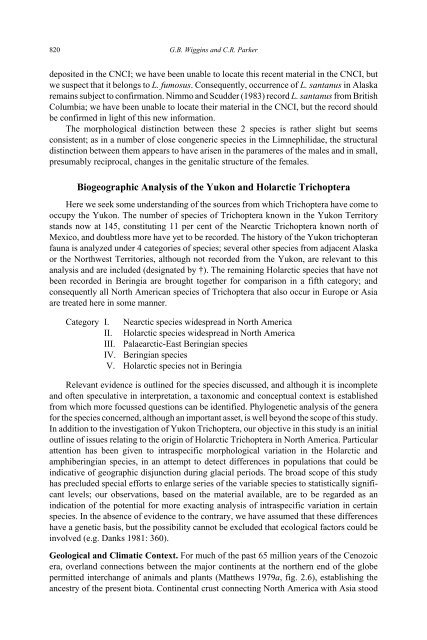Caddisflies of the Yukon - Department of Biological Sciences ...
Caddisflies of the Yukon - Department of Biological Sciences ...
Caddisflies of the Yukon - Department of Biological Sciences ...
You also want an ePaper? Increase the reach of your titles
YUMPU automatically turns print PDFs into web optimized ePapers that Google loves.
820 G.B. Wiggins and C.R. Parker<br />
deposited in <strong>the</strong> CNCI; we have been unable to locate this recent material in <strong>the</strong> CNCI, but<br />
we suspect that it belongs to L. fumosus. Consequently, occurrence <strong>of</strong> L. santanus in Alaska<br />
remains subject to confirmation. Nimmo and Scudder (1983) record L. santanus from British<br />
Columbia; we have been unable to locate <strong>the</strong>ir material in <strong>the</strong> CNCI, but <strong>the</strong> record should<br />
be confirmed in light <strong>of</strong> this new information.<br />
The morphological distinction between <strong>the</strong>se 2 species is ra<strong>the</strong>r slight but seems<br />
consistent; as in a number <strong>of</strong> close congeneric species in <strong>the</strong> Limnephilidae, <strong>the</strong> structural<br />
distinction between <strong>the</strong>m appears to have arisen in <strong>the</strong> parameres <strong>of</strong> <strong>the</strong> males and in small,<br />
presumably reciprocal, changes in <strong>the</strong> genitalic structure <strong>of</strong> <strong>the</strong> females.<br />
Biogeographic Analysis <strong>of</strong> <strong>the</strong> <strong>Yukon</strong> and Holarctic Trichoptera<br />
Here we seek some understanding <strong>of</strong> <strong>the</strong> sources from which Trichoptera have come to<br />
occupy <strong>the</strong> <strong>Yukon</strong>. The number <strong>of</strong> species <strong>of</strong> Trichoptera known in <strong>the</strong> <strong>Yukon</strong> Territory<br />
stands now at 145, constituting 11 per cent <strong>of</strong> <strong>the</strong> Nearctic Trichoptera known north <strong>of</strong><br />
Mexico, and doubtless more have yet to be recorded. The history <strong>of</strong> <strong>the</strong> <strong>Yukon</strong> trichopteran<br />
fauna is analyzed under 4 categories <strong>of</strong> species; several o<strong>the</strong>r species from adjacent Alaska<br />
or <strong>the</strong> Northwest Territories, although not recorded from <strong>the</strong> <strong>Yukon</strong>, are relevant to this<br />
analysis and are included (designated by †). The remaining Holarctic species that have not<br />
been recorded in Beringia are brought toge<strong>the</strong>r for comparison in a fifth category; and<br />
consequently all North American species <strong>of</strong> Trichoptera that also occur in Europe or Asia<br />
are treated here in some manner.<br />
Category I. Nearctic species widespread in North America<br />
II. Holarctic species widespread in North America<br />
III. Palaearctic-East Beringian species<br />
IV. Beringian species<br />
V. Holarctic species not in Beringia<br />
Relevant evidence is outlined for <strong>the</strong> species discussed, and although it is incomplete<br />
and <strong>of</strong>ten speculative in interpretation, a taxonomic and conceptual context is established<br />
from which more focussed questions can be identified. Phylogenetic analysis <strong>of</strong> <strong>the</strong> genera<br />
for <strong>the</strong> species concerned, although an important asset, is well beyond <strong>the</strong> scope <strong>of</strong> this study.<br />
In addition to <strong>the</strong> investigation <strong>of</strong> <strong>Yukon</strong> Trichoptera, our objective in this study is an initial<br />
outline <strong>of</strong> issues relating to <strong>the</strong> origin <strong>of</strong> Holarctic Trichoptera in North America. Particular<br />
attention has been given to intraspecific morphological variation in <strong>the</strong> Holarctic and<br />
amphiberingian species, in an attempt to detect differences in populations that could be<br />
indicative <strong>of</strong> geographic disjunction during glacial periods. The broad scope <strong>of</strong> this study<br />
has precluded special efforts to enlarge series <strong>of</strong> <strong>the</strong> variable species to statistically significant<br />
levels; our observations, based on <strong>the</strong> material available, are to be regarded as an<br />
indication <strong>of</strong> <strong>the</strong> potential for more exacting analysis <strong>of</strong> intraspecific variation in certain<br />
species. In <strong>the</strong> absence <strong>of</strong> evidence to <strong>the</strong> contrary, we have assumed that <strong>the</strong>se differences<br />
have a genetic basis, but <strong>the</strong> possibility cannot be excluded that ecological factors could be<br />
involved (e.g. Danks 1981: 360).<br />
Geological and Climatic Context. For much <strong>of</strong> <strong>the</strong> past 65 million years <strong>of</strong> <strong>the</strong> Cenozoic<br />
era, overland connections between <strong>the</strong> major continents at <strong>the</strong> nor<strong>the</strong>rn end <strong>of</strong> <strong>the</strong> globe<br />
permitted interchange <strong>of</strong> animals and plants (Mat<strong>the</strong>ws 1979a, fig. 2.6), establishing <strong>the</strong><br />
ancestry <strong>of</strong> <strong>the</strong> present biota. Continental crust connecting North America with Asia stood
















